
The recent outbreak of Legionnaires’ disease in New York City has led to dozens becoming sick and multiple fatalities. This incident is part of a concerning trend. According to the Centers for Disease Control and Prevention (CDC), the number of reported Legionnaires’ disease cases in the United States continued to rise in 2025, with outbreaks often occurring in hospitals, senior living centers, and residential buildings.
With this most recent outbreak, city health officials have been investigating the source, with cooling towers once more the likely culprit.
While legionella bacteria thrive in warm, moist conditions like water heaters, fountains, and more, HVAC cooling towers are among the most common reasons for an outbreak of Legionnaires' disease.
Why? A cooling tower's function is to re-cool water that has been used in a building’s HVAC cooling system. To accomplish this, it expels the heat from the system and with the power of evaporative cooling with large fans to reduce the temperature of water before sending it back to chillers for re-cooling. When the tower is not properly maintained and cleaned, the warm water, along with dust, dirt, and debris, becomes a breeding ground for bacterial growth like Legionella, the bacteria that cause Legionnaires’ disease. This air-cooling function causes the “Drift” of tiny water droplets, which can carry bacteria from the tower, infecting other cooling towers and the surrounding community.
Many facility managers believe that water treatment with biocides is enough. However, the outbreak in NYC serves as a stark reminder for facility managers and on-site or contracted maintenance teams of the importance of good water treatment and routine preventative maintenance, including thorough cleaning of their cooling towers.
Goodway Technologies, provider of HVAC industrial maintenance solutions, recommends the following preventative maintenance steps to reduce the risk of Legionella developing in a facility:
- Inspect Cooling Towers Monthly: Examine all tower surfaces for sediment, scale, and slime, which can build up and help Legionella thrive. Put special focus on cooling tower fill, and basins.
- Clean Tower Basin Surfaces Regularly: If there is visible sediment, scale, or slime, then it is time to clean. Using a specialized cleaning system like a cooling tower vacuum makes it fast and easy to conduct frequent cleanings without shutting down or draining the system.
- Clean the Fill: The tower fill is a prime environment for scale and bacterial growth. Ensure proper cleaning using a Chemical Applicator and ScaleBreak-Gel, engineered specifically for cooling towers.
- Treat Circulating Water: Work with a professional water treatment to automatically dose water supplies with appropriate biocides at recommended levels and consider monthly Legionella testing to detect early signs of contamination. Check with local ordinances. Some require monthly, quarterly, or annual inspections.
- Always Disinfect: Regularly disinfect the tower’s surfaces and before any maintenance is to be performed use an EPA registered disinfectant.
“The potential for an outbreak of Legionnaires’ disease increases significantly when routine preventative maintenance is ignored or overlooked,” says Mark Rothenhausen, Sr. Director of Sales Operations. “Facility managers must remain vigilant and ensure that all systems—especially cooling towers—are properly maintained to reduce risk.”
In addition to reducing the risk of Legionella, proper cooling tower maintenance can lead to significant savings in energy and equipment costs. Clean systems improve the efficiency and longevity of chillers, heat exchangers, and pumps.
“Putting together a maintenance plan and developing proper procedures is no longer optional,” adds Rothenhausen. “Taking these steps now can minimize the risks of an outbreak and protect both public health and your bottom line.”

 Celebrating BSCAI's 60th Anniversary eBook
Celebrating BSCAI's 60th Anniversary eBook The Down and Dirty on Cleaning in Virus Season
The Down and Dirty on Cleaning in Virus Season How Surfactant Use is Expanding in Commercial Cleaning
How Surfactant Use is Expanding in Commercial Cleaning